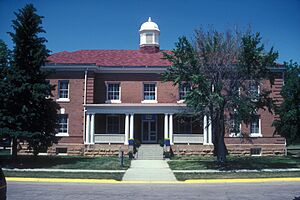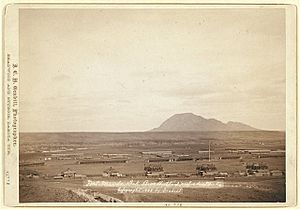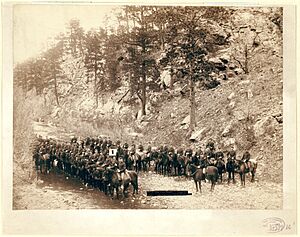Fort Meade (South Dakota) facts for kids
Quick facts for kids Fort Meade |
|
|---|---|
| near Sturgis, South Dakota in United States | |

Fort Meade commanding officer's house, now the museum, 2007
|
|
| Lua error in Module:Location_map at line 420: attempt to index field 'wikibase' (a nil value). | |
| Site information | |
| Controlled by | United States |
| Site history | |
| Built | 1878 |
| In use | 1878-1944 |
| Battles/wars | Indian Wars |
| Garrison information | |
| Past commanders |
|
| Garrison |
|
|
Fort Meade District
|
|
| Area | 3,200 acres (1,300 ha) |
| Architectural style | Greek Revival |
| NRHP reference No. | 73001747 |
| Added to NRHP | May 22, 1973 |
Fort Meade, first called Camp Sturgis and later Camp Ruhlen, is a former United States Army base. It is located just east of Sturgis, South Dakota, in the United States. The fort was active from 1878 to 1944. Today, the area is home to a Veterans Health Administration hospital. It also has training facilities for the South Dakota Army National Guard.
Much of the land that used to be part of the fort is now managed by the Bureau of Land Management. It is known as the Fort Meade Recreation Area. The Fort Meade National Cemetery is also located here. Fort Meade was built in 1878 to protect new settlements. These settlements were in the northern Black Hills near Deadwood, where people were looking for gold. Many travel routes to Deadwood passed through Fort Meade.
For most of the last 130 years, there has been a military presence at Fort Meade. Many cavalry (horse-riding soldiers) and infantry (foot soldiers) units were stationed here. This included the 7th U.S. Cavalry after the Battle of the Little Bighorn. The Buffalo Soldiers of the 25th U.S. Infantry also served here. The 4th U.S. Cavalry saw the change from horses to vehicles here. The 88th Glider Infantry Regiment was also stationed here during World War II.
Fort Meade was named a National Historic District on May 22, 1973. It was the first place in Meade County, South Dakota, to be listed on the National Register of Historic Places. Today, parts of it serve as a public museum.
Contents
History of Fort Meade
How Fort Meade Began
The Fort Laramie Treaty of 1868 set aside the Black Hills of South Dakota for the Lakota people. However, gold was found there in the 1870s. This led many people to enter the area without permission. These newcomers asked the United States Army for protection.
A temporary army camp was set up in August 1876. It was on Spring Creek, north of Bear Butte. This camp was named Camp Sturgis. It honored 2nd Lt. James G. Sturgis, who died at the Battle of the Little Bighorn. During this time, the current site of Fort Meade was chosen. It was located near the eastern Black Hills, by Bear Butte Creek. The permanent military post was officially started on August 31, 1878.
The new post replaced Camp J.C. Sturgis, which began in July 1878. It was about two miles northwest of Bear Butte. It was first called Camp Ruhlen. This name honored Lt. George Ruhlen, who oversaw the building of the post. Major Henry M. Lazelle and soldiers from the 11th U.S. Infantry established it. The site was chosen by Lieutenant General Philip H. Sheridan.
General Order No. 27 announced that the Secretary of War named the post "Fort Meade." This honored Major General George G. Meade, a famous Civil War general. The first commander was Colonel Samuel D. Sturgis, of the 7th Cavalry.
Building the fort began on August 28, 1878. It was finished in August 1879. An initial amount of $100,000 was set aside for construction. More money was later added for the hospital.
Military Actions and Events
Fort Meade was an important center for the United States during the Indian Wars. It also supported the expansion of American settlers into the area. The nearby town of Sturgis grew because of the soldiers and their families. The fort's troops also helped keep peace during land disputes among settlers.
In 1890, soldiers from the Seventh Cavalry at Fort Meade took part in events that led to the Wounded Knee Massacre. This was a sad and tragic event.
Soldiers at Fort Meade later helped resolve a situation with the Ute people between 1906 and 1908. Many Ute moved from Utah to South Dakota. They sought shelter in the Black Hills. After talks broke down, soldiers from Fort Meade's Sixth Cavalry were called in. They moved the Ute to Fort Meade while their leaders negotiated in Washington, D.C.
The Ute camped near Fort Meade. They were watched by the army until the summer of 1907. They were then moved to the Cheyenne River Indian Reservation. However, problems arose when the Ute requested more food. They also did not want their children to attend the residential school. They feared their children would die there.
In October 1907, the Ute began to resist. Cavalry from Fort Meade were sent to the reservation. The situation calmed down quickly. In June 1908, the Ute agreed to return to Utah. They were escorted by the Tenth Cavalry.
It was at Fort Meade that the "Star Spangled Banner" first became the official music for the military retreat ceremony. This happened long before it became the national anthem. In 1892, the post commander, Colonel Caleb H. Carlton, started this custom. He asked everyone to stand and show respect when it was played.
Changes and Closure as a Fort
By the 1890s, the fort was becoming old. The original buildings were aging. The fort's water supply was also threatened by Sturgis's growth. The town's sewer system was too close to the fort's natural spring water source. Brigadier General James F. Wade called the fort "unsanitary."
Fort Meade asked for $150,000 for repairs. Only $30,000 was given at first. Soon after, the U.S. Army decided to close smaller forts. They made Fort Meade a more permanent base. They then invested over $1,000,000 to update the fort. This allowed older buildings to be replaced.
By 1910, the American West had changed. The fort's original purpose was no longer needed. Instead, it became a training ground. It also helped develop new mechanized cavalry units. Fort Meade was mostly empty after World War I. Troops returned for a short time in the mid-1920s.
During the Great Depression, workers from the Civilian Conservation Corps and Works Progress Administration stayed at the fort. They carried out conservation and construction projects. A few smaller army groups continued to be assigned to the fort. By the early years of World War II, the army decided it no longer needed the site for military purposes.
Fort Meade Veterans Administration Hospital
|
Fort Meade Veterans Administration Hospital
|
|
| Built | 1945 |
|---|---|
| MPS | United States Third Generation Veterans Hospitals, 1946–1958 |
| NRHP reference No. | 100002467 |
| Added to NRHP | May 29, 2018 |
Discussions about turning Fort Meade into a hospital for veterans began after World War I. At that time, the need for veterans' health services grew greatly. The final decision to turn the fort into a hospital came in the mid-1940s. The War Department set aside about 8,357 acres (3,382 ha) of land for the new hospital.
German prisoners of war helped turn the site into a hospital. They were overseen by troops from Fort Robinson. They also stayed on as staff until January 1946. The hospital focused on treating veterans' health needs. Old buildings were reused. Barracks became patient housing. Stables became part of the kitchen. The old hospital building housed X-ray and medicine departments.
A farm of about 495-acre (200 ha) was added to provide food and therapy for patients. This farm was removed in the 1960s. About $300,000 was spent on the first construction. The hospital was officially opened on April 6, 1945. Charles Windolph, the last surviving U.S. Army soldier from the Battle of the Little Bighorn, was the guest of honor.
The VA decided to build new, modern buildings later. They hired Ellerbe & Company to design a new complex. Construction finished in the early 1960s. This created two new medical wings with 340 beds. The VA also sold unused parts of the land. By the 1970s, the hospital reached its current size of about 250 acres (100 ha). The VA also removed unused structures and improved the main hospital wing. By 1983, the South Dakota National Guard began using some of the old barracks.
Fort Meade's Garrison History
The first soldiers at Fort Meade included Troops E and M of the Seventh Cavalry. Companies F and K of the First Infantry were also there. Major H. M. Lazelle was in command. In June 1879, more soldiers arrived. Colonel S. D. Sturgis then took command. By September 1879, the fort had four companies of infantry and six troops of cavalry.
In June 1879, a horse named Comanche was brought to Fort Meade. Comanche was the only survivor of the Battle of the Little Bighorn. He was treated very well at Fort Meade until 1888. Then he was taken to Fort Riley, Kansas. He died at Fort Riley a few years later and was buried with military honors. His remains were later preserved. In the early 1900s, Comanche was displayed at the Natural History Museum at the University of Kansas. His display was restored in 2005.
In May 1880, some companies left for Texas. They were replaced by Companies A, D, H, and K of the Twenty-fifth Infantry (colored). Captain D. D. Van Valzah was in temporary command. Colonel Sturgis returned in May 1881 but left in June. After that, different commanders led the post. These included Captain Van Vajzah, Major Edward Ball, and Colonel Joseph G. Tilford. In July 1886, Colonel James W. Forsyth took command.
In 1887, the four companies of the Twenty-fifth Infantry were replaced. Four companies of the Third Infantry arrived. In June 1888, the Seventh Cavalry Regiment moved to Fort Riley, Kansas. The Third Infantry also moved. The post was then filled by the Eighth Cavalry Regiment. It had eight troops under Colonel Elmer Otis. In January 1891, Colonel C. H. Carleton took command. He retired in June 1897, and Colonel John M. Bacon took over.
In 1891, the U.S. Army recruited several Native American troops. The goal was to build peaceful relations. Troop L of the Third Cavalry was at Fort Meade. However, this initiative was ended in 1895.
After the Spanish–American War began, Colonel Bacon was ordered away. Major Robt. McGregor was left in charge. The Eighth Cavalry Regiment, which had been at the post for ten years, was broken up. The last troops left on October 6, 1898. They went to Huntsville, Alabama, before going to Cuba. In October 1898, the fort's soldiers included two troops of the First United States Cavalry. They had been transferred from the battlefields of San Juan Hill and El Caney.
Between World War I and World War II, Fort Meade hosted the Fourth Cavalry. After the Fourth Cavalry went to Europe during World War II, a branch of the Women's Army Corps and the 620th Engineer General Service Company were stationed there briefly until about 1942.
Fort Meade's Buildings and Design
The 3,200-acre (1,300 ha) Fort Meade District includes all of the fort's original and expanded land. This includes the Fort Meade National Cemetery and the current Fort Meade Veterans Administration Hospital. Most of the first wooden buildings are gone. They were replaced in the early 20th century with stronger brick and stone structures.
Most of these new buildings, built between 1900 and 1910, show elements of Greek Revival architecture. More work was done in the 1930s by the Works Progress Administration. Since it was built, the fort has had many different facilities. These included a sawmill, schoolhouse, library, hospital, cemetery, bakery, and barracks. It also had stables for cavalry horses, guardhouses, a recreation hall, and a swimming pool. There were also training grounds and other offices and storage buildings.





